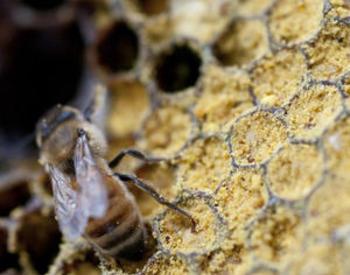Transcript
the Oregon State honeybee lab presents
testing for Naima your sample must
contain at least 100 bees from the
colony of Interest store them in 70%
ethanol or in the freezer until
analysis the items you will need for
analysis will be your stored
sample
forceps
a mortar and
pestal a dish or
container a cutting utensil like a
scapel or micro
scissors a graduated cylinder measuring
up to 100 ml and deionized
water disposable
pipets and a hemocytometer with cover
slip from your sample take out exactly
100 bees with forceps and place in your
container sever the abdomen from the
thorax of each bee using a cutting
utensil and forceps place all abdomen
into the
mortar grind your 100 abdomen with the
pestal it's important that all abdomen
have been thoroughly crushed for a
homogenized
sample measure out 100 ml of deionized
water using your graduated cylinder if
your sample doesn't contain exactly 100
abdomen add 1 mL of water per each B of
your
sample the water will curve at the
surface when poured into the graduated
cylinder make sure to measure using the
bottom of that
curve pour water into the
mortar using your disposable pipet stir
and draw up part of the
sample Place One Drop onto one of the
Triangular spots in the counting chamber
of the hemus autometer carefully place a
cover slip over the counting chamber
turn on the microscope light and set the
power to 400 times then place the hemos
autometer on the microscope and begin to
put in
Focus once your sample is in Focus move
the slide around to find a set of
guidelines we want to find where the
horizontal and vertical guidelines cross
each other since we found the horizontal
guidelines first we will move left and
right to find the vertical
ones we located the upper right hand
corner of the cross-hatching grid
count the total number of nzima spores
within this cornered Square that's
outlined by tripl lined grid
Marks here are some highlighted nzima
spores become familiar with their
distinct shape and outline it may take
some practice to decipher spores from
other debris within the
sample if a NOA Spore Falls within the
Border grid lines do not count the ones
that lie within the left and bottom
border but do count the ones that lie
within the top and right border move the
slide around and count all spores that
lie within each Corner square and the
Very middle square of the grid record
the total number of
spores you will multiply the total
number of counted nazma spores by
50,000 this will give you the estimated
number of nzima spores per B within your
sample for example if you counted 50
spores your first sample contains 2.5
million nazima spores per individual
[Music]
be
Summary
Knowing the levels of Nosema in your apiary and understanding the effects of its presence will enable you to make an educated decision on your treatment plan. In this video, we demonstrate how to process a sample of honey bees for microscopic diagnosis of Nosema for both presence/absence and spore quantification.
Catalog - EM 9146



















